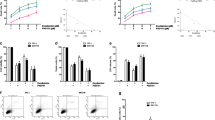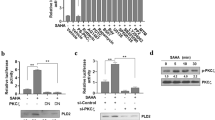Abstract
Histone deacetylase inhibitors and casein kinase 2 inhibitors have been shown to induce apoptosis. However, the combined effect of casein kinase 2 inhibition on the apoptotic effect of histone deacetylase inhibitor is unknown. We assessed the effect of casein kinase 2 inhibition on the apoptotic effect of trichostatin A in human epithelial carcinoma cell lines with respect to cell death signaling pathways. At concentrations that did not induce cell death, the casein kinase 2 inhibitor 4,5,6,7-tetrabromobenzotriazole inhibited activation of apoptotic proteins and changes in mitochondrial membrane permeability induced by the histone deacetylase inhibitor trichostatin A. These results suggest that casein kinase 2 inhibition may reduce trichostatin A-induced apoptosis in ovarian carcinoma cell lines by suppressing activation of apoptotic proteins and changes in mitochondrial membrane permeability, which both lead to caspase-3 activation. Casein kinase 2 inhibition, which does not induce a cytotoxic effect, may prevent histone deacetylase inhibitor-mediated apoptosis.








Similar content being viewed by others

Abbreviations
- TBB:
-
4,5,6,7-tetrabromobenzotriazole
- MTT:
-
3-(4,5-Dimethylthiazol-2-yl)-2,5-diphenyltetrazolium bromide
References
Rasheed WK, Johnstone RW, Prince HM (2007) Histone deacetylase inhibitors in cancer therapy. Expert Opin Investig Drugs 16:659–678. doi:10.1517/13543784.16.5.659
Glaser KB (2007) HDAC inhibitors: clinical update and mechanism-based potential. Biochem Pharmacol 74:659–671. doi:10.1016/j.bcp.2007.04.007
Platta CS, Greenblatt DY, Kunnimalaiyaan M, Chen H (2007) The HDAC inhibitor trichostatin A inhibits growth of small cell lung cancer cells. J Surg Res 142:219–226. doi:10.1016/j.jss.2008.03.008
Wu ZQ, Zhang R, Chao C, Zhang JF, Zhang YQ (2007) Histone deacetylase inhibitor trichostatin A induced caspase-independent apoptosis in human gastric cancer cell. Chin Med J 120:2112–2118
Sonnemann J, Hüls I, Sigler M, Palani CD, le Hong TT, Völker U, Kroemer HK, Beck JF (2008) Histone deacetylase inhibitors and aspirin interact synergistically to induce cell death in ovarian cancer cells. Oncol Rep 20:219–224
Sonnemann J, Kumar KS, Heesch S, Müller C, Hartwig C, Maass M, Bader P, Beck JF (2006) Histone deacetylase inhibitors induce cell death and enhance the susceptibility to ionizing radiation, etoposide, and TRAIL in medulloblastoma cells. Int J Oncol 28:755–766
Arnold NB, Arkus N, Gunn J, Korc M (2007) The histone deacetylase inhibitor suberoylanilide hydroxamic acid induces growth inhibition and enhances gemcitabine-induced cell death in pancreatic cancer. Clin Cancer Res 13:18–26. doi:10.1158/1078-0432.CCR-06-0914
Pan L, Lu J, Wang X, Han L, Zhang Y, Han S, Huang B (2007) Histone deacetylase inhibitor trichostatin a potentiates doxorubicin-induced apoptosis by up-regulating PTEN expression. Cancer 109:1676–1688. doi:10.1002/cncr.22585
Rosato RR, Grant S (2003) Histone deacetylase inhibitors in cancer therapy. Cancer Biol Ther 2:30–37
Duan H, Heckman CA, Boxer LM (2005) Histone deacetylase inhibitors down-regulate bcl-2 expression and induce apoptosis in t(14;18) lymphomas. Mol Cell Biol 25:1608–1619. doi:10.1128/MCB.25.5.1608-1619.2005
Kumar KS, Sonnemann J, Beck JF (2006) Histone deacetylase inhibitors induce cell death in supratentorial primitive neuroectodermal tumor cells. Oncol Rep 16:1047–1052
Allende JE, Allende CC (1995) Protein kinase 4. Protein kinase CK2: an enzyme with multiple substrates and a puzzling regulation. FASEB J 9:313–323
Ahmad KA, Wang G, Unger G, Slaton J, Ahmed K (2008) Protein kinase CK2—a key suppressor of apoptosis. Adv Enzyme Regul 48:179–187. doi:10.1016/j.advenzreg.2008.04.002
Duncan JS, Litchfield DW (2008) Too much of a good thing: the role of protein kinase CK2 in tumorigenesis and prospects for therapeutic inhibition of CK2. Biochim Biophys Acta 1784:33–47. doi:10.1016/j.bbapap.2007.08.017
Pallares J, Llobet D, Santacana M, Eritja N, Velasco A, Cuevas D, Lopez S, Palomar-Asenjo V, Yeramian A, Dolcet X, Matias-Guiu X (2009) CK2β is expressed in endometrial carcinoma and has a role in apoptosis resistance and cell proliferation. Am J Pathol 174:287–296. doi:10.2353/ajpath.2009.080552
Torkin R, Lavoie JF, Kaplan DR, Yeger H (2005) Induction of caspase-dependent, p53-mediated apoptosis by apigenin in human neuroblastoma. Mol Cancer Ther 4:1–11
Ahmad KA, Wang G, Ahmed K (2006) Intracellular hydrogen peroxide production is an upstream event in apoptosis induced by down-regulation of casein kinase 2 in prostate cancer cells. Mol Cancer Res 4:331–338. doi:10.1158/1541-7786.MCR-06-0073
Chiang LC, Ng LT, Lin IC, Kuo PL, Lin CC (2006) Anti-proliferative effect of apigenin and its apoptotic induction in human Hep G2 cells. Cancer Lett 237:207–214. doi:10.1016/j.canlet.2005.06.002
Wang CN, Chi CW, Lin YL, Chen CF, Shiao YJ (2001) The neuroprotective effects of phytoestrogens on amyloid β protein-induced toxicity are mediated by abrogating the activation of caspase cascade in rat cortical neurons. J Biol Chem 276:5287–5295. doi:10.1074/jbc.M006406200
Kang SS, Lee JY, Choi YK, Kim GS, Han BH (2004) Neuroprotective effects of flavones on hydrogen peroxide-induced apoptosis in SH-SY5Y neuroblostoma cells. Bioorg Med Chem Lett 14:2261–2264. doi:10.1016/j.bmcl.2004.02.003
Silva B, Oliveira PJ, Dias A, Malva JO (2008) Quercetin, kaempferol and biapigenin from Hypericum perforatum are neuroprotective against excitotoxic insults. Neurotox Res 13:265–279
Zhou C, Qiu L, Sun Y, Healey S, Wanebo H, Kouttab N, Di W, Yan B, Wan Y (2006) Inhibition of EGFR/PI3 K/AKT cell survival pathway promotes TSA’s effect on cell death and migration in human ovarian cancer cells. Int J Oncol 29:269–278
Nishioka C, Ikezoe T, Yang J, Koeffler HP, Yokoyama A (2005) Inhibition of MEK/ERK signaling synergistically potentiates histone deacetylase inhibitor-induced growth arrest, apoptosis and acetylation of histone H3 on p21waf1 promoter in acute myelogenous leukemia cell. Leukemia 22:1449–1452. doi:10.1038/sj.leu.2405079
Mosmann T (1983) Rapid colorimetric assay for cellular growth and survival: application to proliferation and cytotoxicity assays. J Immunol Methods 65:55–63. doi:10.1016/0022-1759(83)90303-4
Oberhammer FA, Pavelka M, Sharma S, Tiefenbacher R, Purchio AF, Bursch W, Schulte-Hermann R (1992) Induction of apoptosis in cultured hepatocytes and in regressing liver by transforming growth factor β1. Proc Natl Acad Sci 89:5408–5412
Berthier A, Lemaire-Ewing S, Prunet C, Monier S, Athias A, Bessede G, Pais de Barros JP, Laubriet A, Gambert P, Nèel D (2004) Involvement of a calcium-dependent dephosphorylation of BAD associated with the localization of Trpc-1 within lipid rafts in 7-ketocholesterol-induced THP-1 cell apoptosis. Cell Death Differ 11:897–905. doi:10.1038/sj.cdd.4401434
Jin Z, El-Deiry WS (2005) Overview of cell death signaling pathways. Cancer Biol Ther 4:139–163
Hu W, Kavanagh JJ (2003) Anticancer therapy targeting the apoptotic pathway. Lancet Oncol 4:721–729. doi:10.1016/S1470-2045(03)01277-4
Armstrong JS (2006) Mitochondria: a target for cancer therapy. Br J Pharmacol 147:239–248. doi:10.1038/sj.bjp.0706556
Ruefli AA, Ausserlechner MJ, Bernhard D, Sutton VR, Tainton KM, Kofler R, Smyth MJ, Johnstone RW (2001) The histone deacetylase inhibitor and chemotherapeutic agent suberoylanilide hydroxamic acid (SAHA) induces a cell-death pathway characterized by cleavage of Bid and production of reactive oxygen species. Proc Natl Acad Sci 98:10833–10838. doi:10.1073/pnas.191208598
Chipuk JE, Green DR (2006) Dissecting p53-dependent apoptosis. Cell Death Differ 13:994–1002. doi:10.1038/sj.cdd.4401908
Wiman KG (2006) Strategies for therapeutic targeting of the p53 pathway in cancer. Cell Death Differ 13:921–926. doi:10.1038/sj.cdd.4401921
Izeradjene K, Douglas L, Delaney A, Houghton JA (2005) Casein kinase II (CK2) enhances death-inducing signaling complex (DISC) activity in TRAIL-induced apoptosis in human colon carcinoma cell lines. Oncogene 24:2050–2058. doi:10.1038/sj.onc.1208397
Wang G, Ahmad KA, Ahmed K (2005) Modulation of death receptor-mediated apoptosis by CK2. Mol Cell Biochem 274:201–205
Acknowledgments
This study was supported by a grant of the Korea Healthcare Technology R&D Project, Ministry for Health, Welfare & Family Affairs, Republic of Korea (A085138).
Author information
Authors and Affiliations
Corresponding author
Rights and permissions
About this article
Cite this article
Lee, C.S., Jang, ER., Kim, Y.J. et al. Casein kinase 2 inhibition differentially modulates apoptotic effect of trichostatin A against epithelial ovarian carcinoma cell lines. Mol Cell Biochem 338, 157–166 (2010). https://doi.org/10.1007/s11010-009-0349-1
Received:
Accepted:
Published:
Issue Date:
DOI: https://doi.org/10.1007/s11010-009-0349-1



